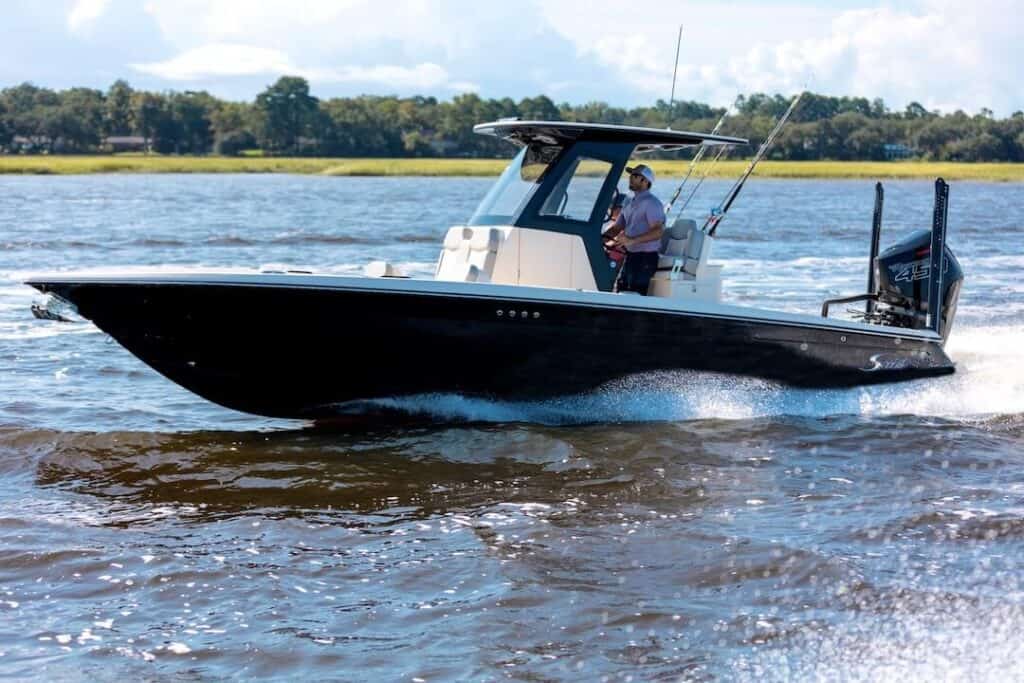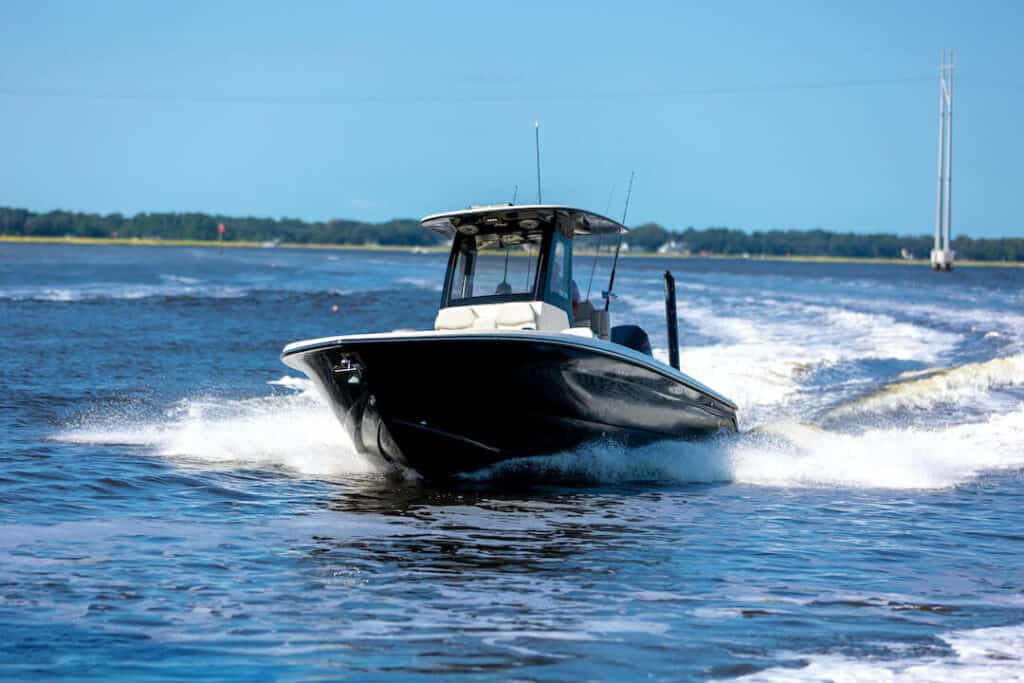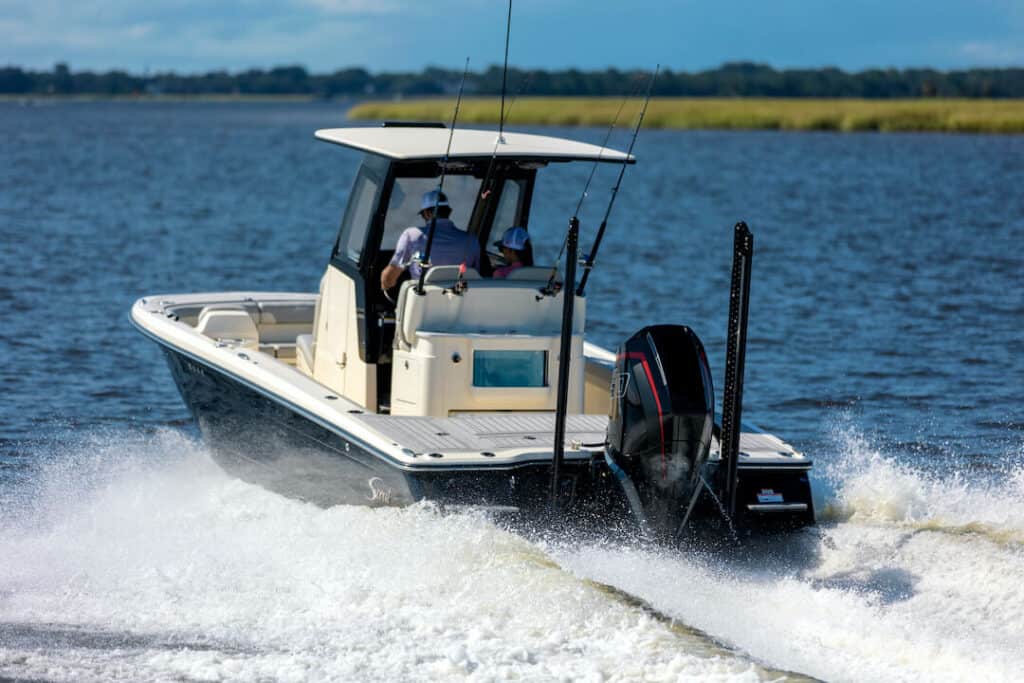
The flats called to me in my dreams for ages, but now I stood on the deck of my boat and saw them as the sun exposed the shallow depths for the first time. While other anglers chased permit and snook, my eyes searched the water for sharks.
It didn’t take long for the chum to work and the fins to appear. The shark’s bodies were simply too large for the shallow flats we fished, but that worked to my advantage. Hauling and double hauling, I let the large orange popper sail through the air into the crystal-clear water. Its sudden impact caused an abrupt snap in the heads of every shark around our boat.
With each twitch and splash, the popper brought the sharks around it closer and closer. Surely, time presented the only obstacle to the massive fight I yearned for. With each strip of the line, my imagination flashed a strike, landing, and a picture on my computer background of me holding a nice lemon shark caught in the keys.
With a sudden boil on top of the water cut with a grey pectoral fin, a shark darted at my fly, and the fight of fights erupted in my hands. I couldn’t believe it. This is the Shark on a fly.
All About Sharks
Sharks are vital as apex predators, regulating prey populations and maintaining ecosystem balance. Some species, such as the great white and scalloped hammerhead, are listed as vulnerable or endangered, prompting conservation efforts.
Shark fishing is regulated with size and bag limits, permits, and restrictions on vulnerable species to ensure sustainability and prevent overfishing. Ongoing efforts in research, conservation, and public awareness contribute to our understanding and protection of these captivating creatures.
Different shark species have specific habitat preferences based on their feeding habits, migration patterns, and physiological adaptations. For example, some sharks, like the great white, are known to frequent coastal regions and nearshore areas where their prey is abundant. Other species, such as hammerhead sharks, are often found patrolling coral reefs and using their unique head shape to enhance their sensory abilities.
Where to Find Shark
Sharks in America inhabit diverse marine environments along the Atlantic and Pacific coasts and the Gulf of Mexico. America has various shark species, including the great white, tiger, bull, hammerhead, mako, and thresher sharks.
Sharks inhabit a wide range of marine habitats across the world, including the coastal waters of America. These remarkable creatures can be found in various environments, such as nearshore areas, coral reefs, offshore waters, and even deep-sea regions.
Packing the Tacklebox

When selecting the right tackle, however, it is extremely important when fly fishing for sharks. Because they are excessively strong, have blades for teeth, and their skin cuts like heavy grit sandpaper, choosing the right tackle will determine if you land a shark.
Rods—A stiff rod for throwing flies that will get a shark’s attention, as well as handling them when they bite, is a must. Lighter rods will fold under the intense ferocity of fighting a shark, no matter the species. Therefore, using at least a 10-weight rod is essential. Such a heavy rod will allow you to throw the flies that sharks will be able to notice going through the water and still allow you to land them when you hook up.
Reels— For shark fishing, you will need a large arbor reel with a rock-solid drag that is intended for use in salt water. Large arbor reels allow you to reel in faster when fighting a shark, capitalizing on the moments when they slow down or turn. However, the most important part is quite obviously the drag. Sharks are powerful fish that can easily stretch and break a line that isn’t well managed. Having a heavy, high-quality drag will allow you to slow the shark down and wear him out.
Leaders—Of all the pieces of tackle used when fly fishing, the leader stands apart in importance. Since the shark will likely run away from you, the leader will rake across his skin during the fight. Sharks are well known for their sandpaper-like skin and will cut any leader not made of the right material. A heavy, abrasion-resistant monofilament leader is incredibly important for successfully landing a shark.
Flies— Shark fly fishing can be done in a variety of ways. If you are on the flats, in shallow water, one of the best things you can use for sharks is large poppers. These flies create pressure waves that the sharks use to hone in on their prey. In deeper water, where fishing on the surface is less than ideal, large streamers can do the trick but are less effective. In those situations, some captains attach other bait fish to their flies to incentivize the sharks to bite.
Hooks— Use a #1 or #2 blue water hook if you are targeting small sharks that roam the flats. However, if you are in deeper water and want to snag significantly larger sharks, upgrading to a #5 may be more in order. Sharks come in various sizes and can be caught with different techniques. Selecting the right hook for the type of fishing you are doing is of paramount importance.
Tips for Catching Shark on a Fly
Chum It Up- Sharks are the vultures of the ocean, and consequently, they largely hunt with their nose. Though creating pressure waves will get their attention once they are in your sphere of influence, the way to bring them in is with scent. Chumming the water, especially in the flats, will flood the area around you with sharks. Once they are there, casting them is done by sight relatively easily.
Be A Temptress- Sharks are very intelligent. Due to that, they are very curious. If you allow the shark to nose or nudge your fly, the shark will figure out that it isn’t something they want to eat and will move on. Therefore, try to keep your fly away from the shark as long as possible when you retrieve it. This will give the shark the idea that it is trying to run, and the shark will instinctively chase it down.
Orange Is The Way- Though no one understands why, orange seems to be a color shark that can either see better than other colors or is instinctively attracted to it. Either way, using an orange-colored fly will result in more bites at the end of a long day of fishing. Have a strong bias for orange or red in your fly color selection and experience an outsize number of bites.
Catching Shark with Scout Boats
When trying to catch a shark on a fly, you will need a boat that can survive in the blue water and navigate short, shallow flats. You also need a place to cast easily and enough room to handle the larger sharks you will inevitably bring in. Having the right boat for fly fishing for sharks is just as essential as having the right pole.
The 281 XSS is just such a boat. With a large forward-casting deck, you can cast and fight the shark relatively easily. The aft deck allows easy access to the water and plenty of room to work on a fighting shark without damaging the rest of the boat. No matter what shark species you are casting to, the 281 XSS is the best place to land them.


